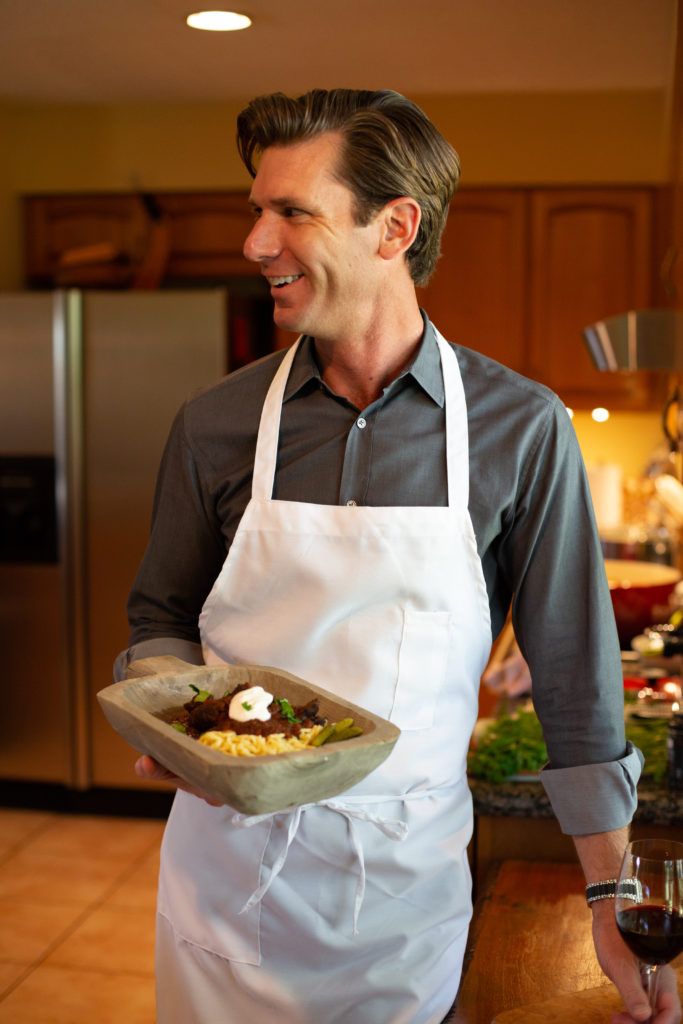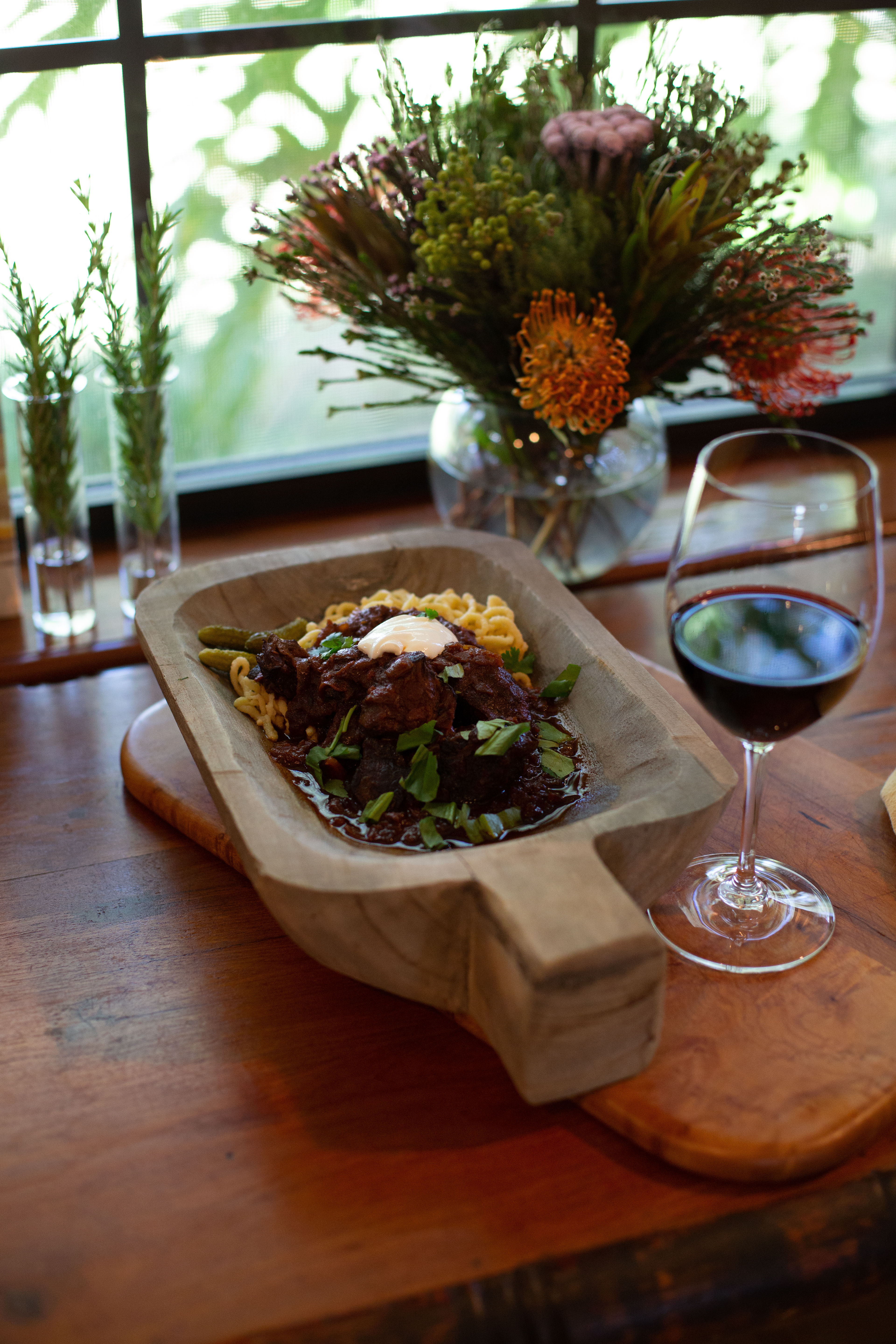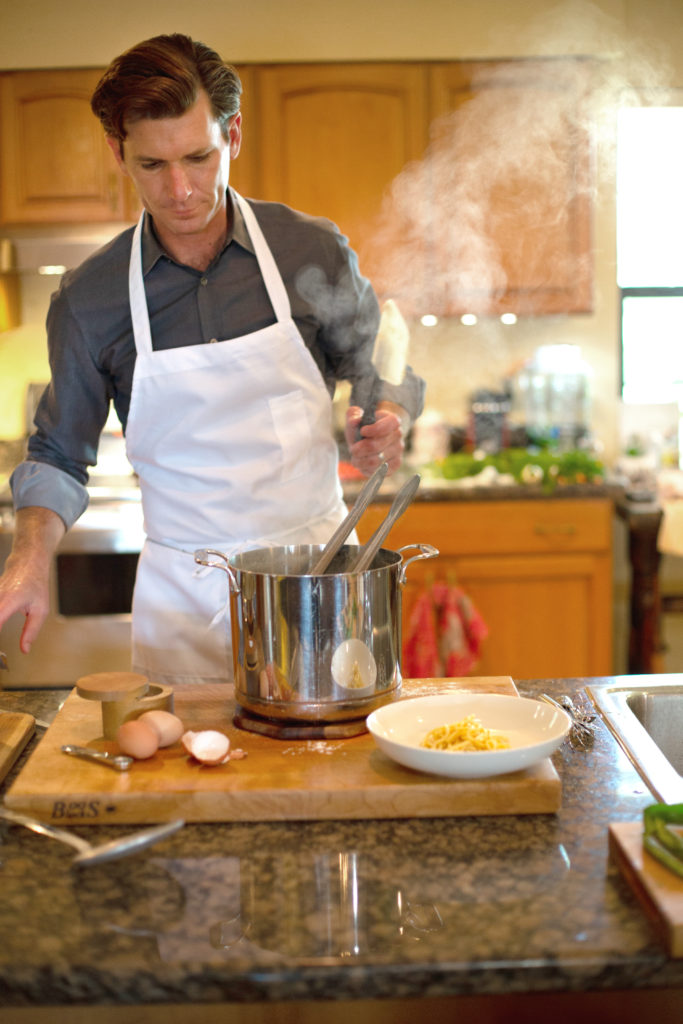 This busy equine veterinarian doesn’t often have time to cook, but when he does, you can certainly expect something spectacular.
This busy equine veterinarian doesn’t often have time to cook, but when he does, you can certainly expect something spectacular.
Dr. Nathan Mitts is a self-described “scientist” in the kitchen. His “experiments” are precisely prepared dishes with complex flavor profiles, fresh herbs and healthy ingredients that taste so good even his 3-year-old daughter Heidi enjoys eating them. His busy schedule doesn’t allow him to cook as often as he’d like, but when he does, it’s as much about the process as it is about the end result.
“If I do have a day off, I love for it to be spent in the kitchen,” he confesses. He and his wife Amanda have created a cozy kitchen that’s the heart of their home overlooking the rolling pastures of their northwest Marion County farm. It has warm touches—natural wood serving platters, an old-fashioned mortar and pestle and a treasured vintage spaetzle (noodle) press brought over from Germany by Amanda’s grandmother. They love nothing better than hosting family for a home-cooked, leisurely meal enjoyed with a bottle of wine and plenty of good conversation.
“We all travel a lot so when we’re in town we tend to eat on the farm,” Mitts explains. “It’s so much fun to cook and to share the spoils with the family and those you love. Cooking for people is so different than a restaurant meal. It’s such a shared experience when everyone is eating the same thing. But it’s also the eat to live philosophy—things that are natural and flavorful that you can feel better about eating.”
To get just the right ingredients, Mitts shops the specialty markets in Gainesville, or if he’s lucky, plucks some fresh herbs from his in-laws’ garden. His scientific approach to cooking means everything is precise and carefully planned, from edible flowers for pops of color and beautiful presentation to cooking with the same wine he’s selected to pair with the meal. If you’re lucky enough to partake in one of Mitts’ specialties, like the venison porkolt he enjoys preparing in the fall, you can be sure he has perfected the balances of salt, fat, acid and heat, and has purposefully selected each ingredient, from the vibrant red imported Hungarian sweet and hot paprikas to the “integral” French cornichon pickle and Icelandic yogurt garnishes. Often, daughter Heidi keeps him company while he cooks.
“She follows the energy and the energy is in the kitchen,” he says. “She is attentive to what we’re doing. We’ve never ‘cooked around her’ so to speak; she’s always eaten what we eat.”
Growing up in Missouri, Mitts remembers his mother often cooked “three square meals a day.” As an adult, he admits he “ruined so many good pieces of meat on the grill” that he began to try braising and pan-frying techniques instead. Because of his preference for organic meat with traceable sources, he appreciates game acquired from friends who hunt. Mitts learned a lot about preparing wild game from the Hunter Angler Gardener Cook website by former restaurant cook and cookbook author Hank Shaw. His current secret ingredient is duck fat. “Things get browned in duck fat,” he reveals. “It makes everything better.”
After the busy fall season, which keeps Mitts on the road examining sport horses at sales around the country, he looks forward to Thanksgiving, his favorite holiday, and more time at home to enjoy his family, which also means more time spent together in the kitchen. “I think the kitchen is the pulse of the home, the real soul.”

Venison Porkolt and Spaetzle
Serves 6
Editor’s note: This is Mitts’ variation on a recipe inspired by Hunter Angler Gardener Cook, so it includes instructions on butchering and aging your own game and cutting the bones. But don’t be dissuaded if you’re not comfortable doing that. Simply start at Step 3 using a store-bought lamb or beef roast (approximately 2 ½ pounds), a high-quality packaged bone broth, any egg noodle and plan around three hours to cook on the stove. To make it even easier, you can even place the browned meat and other ingredients in a slow cooker in the morning for a ready-to-eat meal after work.
Step 1
Field dress a venison shoulder or shank. Ship in ice. Trim any bloodshot or heavily bruised areas. Disarticulate the joints if necessary. Dry age in a clean refrigerator for 48-72 hours. (I simply place the pieces on a wire rack in a cookie sheet and rotate the meat every 12 hours.) Wrap in cheesecloth once the surface is dry or tacky. Cut the meat off the bone and leave in large 4-inch chunks. Dry age those overnight while you make the broth.
Step 2
If necessary, cut the bones with a hacksaw so that after roasting they will fit into a large stockpot. Rub them with olive oil and salt and roast at 400° until brown. Place the roasted bones in a large stockpot and cover with cold water. Bring to a simmer over medium-high heat then reduce heat to maintain a gentle steamy simmer overnight (6+ hours). Skim and discard the foam off the top from time to time. Add the following to the pot:
Broth
- 2 carrots, chopped
- 2 celery stalks, chopped
- 2 leeks, chopped
- 1-2 parsnips, chopped
- 1/2 bunch flat-leaf parsley, chopped
- 2 tablespoons rosemary
- 1-2 tablespoons juniper berries, crushed
- 1 tablespoon black peppercorns, crushed
- 1 tablespoon thyme
- 4-6 bay leaves
After 2 hours at a gentle simmer, remove everything you can with tongs, then pour through a cheesecloth-lined fine wire mesh sieve and collect the broth in a stockpot. Taste, carefully salt, and reduce if necessary. Hold back a quart and freeze the rest for another day.
 Meat/Venison
Meat/Venison
- 3 pounds yellow onions, chopped
- 4-5 cups broth
- 1/3 bottle of wine
- 1 1/2 cups crushed tomatoes
- 1/3 cup Hungarian sweet paprika
- 2-3 tablespoons duck fat
- 1 tablespoon caraway seeds
- 1 tablespoon hot paprika
- 1/2 tablespoon marjoram
- Step 3 (Start here for store-bought or butcher-cut meat.)
Bring your venison to room temperature. Heat duck fat in a large Dutch oven over medium-high heat. In batches, brown the venison evenly on all sides, salting as you go. Remove the venison and set aside. Add more duck fat to the pot if needed—there needs to be just enough to coat the bottom of the pot. Add onions and caraway seeds and slowly brown over medium-low to medium heat with a gentle hiss and sizzle and an occasional stir. (This tends to take an hour or so and I cover it after 30 or 45 minutes.)
Return the venison to the pot and add sweet paprika, hot paprika, marjoram and crushed tomatoes, and enough of your broth and red wine to cover everything—usually 4-5 cups broth and 1/3 of bottle of wine. (Cook with the wine that you plan to serve with the meal. Mitts suggests serving Northern Rhones with this recipe.) Mix everything well and bring to a simmer. Cover and cook on low heat at a cheery simmer until the meat can be easily separated with a potato masher—about 6-8 hours, but will vary depending upon the age, cut, and condition of the meat.
Spaetzle:
- 4 eggs, beaten
- 2 cups flour
- 1 teaspoon salt
- Milk-enough to thin
For the spaetzle, bring a large pot of salty water to a rolling boil. Make a dough with the flour, eggs and salt, and just add enough milk to thin it somewhat—it will need to be able to be squeezed through the press. Dunk the press and the blade of a table knife into the boiling water, then fill the press with dough and quickly squeeze into the water and cut the noodles from the press with the table knife. Give everything a little stir. Cook these in batches so as not to overcrowd. Once the noodles are floating, give them another 30-45 seconds to cook up, then remove them with a slotted spoon and place in a warmed bowl.
Plate a generous helping of porkolt alongside some spaetzle and top with a dollop of yogurt, a few sliced cornichons, some chopped cilantro and serve.






